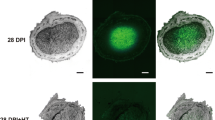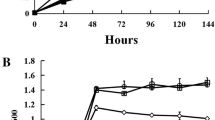Abstract
Aim
Hydrogen sulphide (H2S), as a signalling molecule, regulates the process of plant growth and development. H2S is involved in the establishment of the legume and rhizobial symbiotic relationship, but little is known about the role of H2S during nodule senescence.
Method
We studied the function of H2S during nodule senescence in the Glycine max-Sinorhizobium fredii symbiotic system. Physiological and biochemical methods were used to modulate nitrogen fixation, nodule structure, senescence-related protein and gene expression.
Results
Our results indicated that H2S decreased the senescent nodule number, increased nitrogenase (Nase) activity and ureide content, and further promoted the accumulation of NO3−-N, NH4+-N, and total N, which caused the accumulation of biomass in the late steps of symbiosis. H2S alleviated nodule senescence by maintaining the normal nitrogen fixation structure of nodules. Meanwhile, the expression levels of the NifH and NodGS proteins and the N metabolic enzyme activities were enhanced by H2S during nodule senescence. Moreover, H2S stimulated the expression of nitrogen metabolism-related genes in the nodules. Finally, senescence-related gene expression levels were regulated by H2S during nodule senescence.
Conclusion
These findings suggested that H2S prolonged the lifespan of N2 fixation by delaying nodule senescence, which will be important for increasing soybean yield and agricultural sustainability development.










Similar content being viewed by others
References
Alesandrini F, Mathis R, Van de Sype G, Hérouart D, Puppo A (2003) Possible roles for a cysteine protease and hydrogen peroxide in soybean nodule development and senescence. New Phytol 158:131–138
Aroca A, Zhang J, Xie Y, Romero LC, Gotor C (2021) Hydrogen sulfide signaling in plant adaptations to adverse conditions: molecular mechanisms. J Exp Bot 72:5893–5904
Baudouin E, Pieuchot L, Engler G, Pauly N, Puppo A (2006) Nitric oxide is formed in Medicago truncatula-Sinorhizobium meliloti functional nodules. Mole Plant-Micro Inter 19:970–975
Baudouin E, Poilevey A, Hewage NI, Cochet F, Puyaubert J, Bailly C (2016) The significance of hydrogen sulfide for Arabidopsis seed germination. Front Plant Sci 7:930
Cam Y, Pierre O, Boncompagni E, Hérouart D, Meilhoc E, Bruand C (2012) Nitric oxide (NO): a key player in the senescence of Medicago truncatula root nodules. New Phytol 196:548–560
Chen J, Wu FH, Wang WH, Zheng CJ, Lin GH, Dong XJ, He JX, Pei ZM, Zheng HL (2011) Hydrogen sulphide enhances photosynthesis through promoting chloroplast biogenesis, photosynthetic enzyme expression, and thiol redox modification in Spinacia oleracea seedlings. J Exp Bot 62:4481–4493
Chen J, Shang YT, Zhang NN, Zhong Y, Wang WH, Zhang JH, Shangguan ZP (2018) Sodium hydrosulfide modifies the nutrient ratios of soybean (Glycine max) under iron deficiency. J Plant Nutri Soil Sci 181:305–315
Chen J, Liu WY, Zhang WQ, Zhang YM, Zhao YW, Wei GH (2022) Effects of sodium hydrosulfide and rhizobia on the growth rate, nutrient stoichiometry, and nutrient resorption of soybean (Glycine max L.). J Plant Nutri Soil Sci 185:69–86
Chou MX, Xia CC, Feng Z, Sun YL, Zhang DH, Zhang MZ, Wang L, Wei GH (2016) A translationally controlled tumor protein gene Rpf41 is required for the nodulation of Robinia pseudoacacia. Plant Mole Biol 90:389–402
Chungopast S, Hirakawa H, Sato S, Handa Y, Saito K, Kawaguchi M, Tajima S, Nomura M (2014) Transcriptomic profiles of nodule senescence in Lotus japonicus and Mesorhizobium loti symbiosis. Plant Biotech 31:345-U115
de Zélicourt A, Diet A, Marion J, Laffont C, Ariel F, Moison M, Zahaf O, Crespi M, Gruber V, Frugier F (2012) Dual involvement of a Medicago truncatula NAC transcription factor in root abiotic stress response and symbiotic nodule senescence. Plant J 70:220–230
Deng J, Zhu FG, Liu JX, Zhao YF, Wen JQ, Wang T, Dong JL (2019) Transcription factor bHLH2 represses CYSTEINE PROTEASE77 to negatively regulate nodule senescence. Plant Physiol 181:1683–1703
Doskočilová A, Plíhal O, Volc J, Chumová J, Kourová H, Halada P, Petrovská B, Binarová P (2011) A nodulin/glutamine synthetase-like fusion protein is implicated in the regulation of root morphogenesis and in signalling triggered by flagellin. Planta 234:459–476
Du X, Jin Z, Zhang L, Liu X, Yang G, Pei Y (2019) H2S is involved in ABA-mediated stomatal movement through MPK4 to alleviate drought stress in Arabidopsis thaliana. Plant Soil 435:295–307
Fedorova M, van de Mortel J, Matsumoto PA, Cho J, Town CD, VandenBosch KA, Gantt JS, Vance CP (2002) Genome-wide identification of nodule-specific transcripts in the model legume Medicago truncatula. Plant Physiol 130:519–537
Filipovic MR, Jovanović VM (2017) More than just an intermediate: hydrogen sulfide signalling in plants. J Exp Bot 68:4733–4736
Fishbeck K, Evans HJ, Boersma LL (1973) Measurement of nitrogenase activity of intact legume symbionts in situ using the acetylene reduction assay. Agron J 65:429–433
Fox JE, Gulledge J, Engelhaupt E, Burow ME, Mclachlan JA (2007) Pesticides reduce symbiotic efficiency of nitrogen-fixing rhizobia and host plants. Pro Nat Acad Sci 104:10282–10287
Fukudome M, Watanabe E, Osuki KI, Imaizumi R, Aoki T, Becana M, Uchiumi T (2018) Stably transformed Lotus japonicus plants overexpressing phytoglobin LjGlb1-1 show decreased nitric oxide levels in roots and nodules as well as delayed nodule senescence. Plant Cell Physiol 60:816–825
González EM, Gálvez L, Arrese-Igor C (2001) Abscisic acid induces a decline in nitrogen fixation that involves leghaemoglobin, but is independent of sucrose synthase activity. J Exp Bot 52:285–293
Grudkowska M, Zagdańska B (2004) Multifunctional role of plant cysteine proteinases. Acta Bioch Polo 51:609–624
Guinel FC (2015) Ethylene, a hormone at the center-stage of nodulation. Front Plant Sci 6:1121
Hu H, Liu D, Li P, Shen W (2015) Hydrogen sulfide delays leaf yellowing of stored water spinach (Ipomoea aquatica) during dark-induced senescence by delaying chlorophyll breakdown, maintaining energy status and increasing antioxidative capacity. Posth Biol Tech 108:8–20
Huo J, Huang D, Zhang J, Fang H, Wang B, Wang C, Liao W (2018) Hydrogen sulfide: A gaseous molecule in postharvest freshness. Front Plant Sci 9:1172
Kardailsky IV, Brewin NJ (1996) Expression of cysteine protease genes in pea nodule development and senescence. Mole Plant-Micro Inter 9:689–695
Li L, Bhatia M, Moore PK (2006) Hydrogen sulphide-a novel mediator of inflammation? Curr Opin Pharm 6:125–129
Liu X, Chen J, Wang GH, Wang WH, Shen ZJ, Luo MR, Gao GF, Simon M, Ghoto K, Zheng HL (2016) Hydrogen sulfide alleviates zinc toxicity by reducing zinc uptake and regulating genes expression of antioxidative enzymes and metallothioneins in roots of the cadmium/zinc hyperaccumulator Solanum nigrum L. Plant Soil 400:177–192
Malik NSA, Pfeiffer NE, Williams DR, Wagner FW (1981) Peptidohydrolases of soybean root nodules. identification, separation and partial characterization of enzymes from bacteroid-free extracts. Plant Physiol 68:386–392
Matamoros MA, Baird LM, Escuredo PR, Dalton DA, Minchin FR, Iturbe-Ormaetxe IA, Rubio MC, Moran JF, Gordon AJ, Becana M (1999) Stress-induced legume root nodule senescence. hysiological, biochemical, and structural alterations1. Plant Physiol 121:97–112
Nap JP, Bisseling T (1990) Developmental biology of a plant-prokaryote symbiosis: The legume root nodule. Science 250:948–954
Oh CJ, Lee H, Kim HB, An CS (2004) Isolation and characterization of a root nodule-specific cysteine proteinase cDNA from soybean. J Plant Biol 47:216–220
Pladys D, Rigaud DJ (1991) Localization of a protease in protoplast preparations in infected cells of French Bean nodules. Plant Physiol 97:1174–1180
Pladys D, Vance CP (1993) Proteolysis during development and senescence of effective and plant gene-controlled ineffective alfalfa nodules. Plant Physiol 103:379–384
Puppo A, Groten K, Bastian F, Carzaniga R, Soussi M, Lucas MM, De Felipe MR, Harrison J, Vanacker H, Foyer CH (2005) Legume nodule senescence: roles for redox and hormone signalling in the orchestration of the natural aging process. New Phytol 165:683–701
Roberts IN, Caputo C, Criado MV, Funk C (2012) Senescence-associated proteases in plants. Physiol Plant 145:130–139
Scuffi D, Nietzel T, Di Fino LM, Meyer AJ, Lamattina L, Schwarzländer M, Laxalt AM, García-Mata C (2018) Hydrogen sulfide increases production of NADPH oxidase-dependent hydrogen peroxide and phospholipase D-derived phosphatidic acid in guard cell signaling. Plant Physiol 176:2532–2542
Serova TA, Tsyganova AV, Tikhonovich IA, Tsyganov VE (2019) Gibberellins inhibit nodule senescence and stimulate nodule meristem bifurcation in Pea (Pisum sativum L.). Front Plant Sci 10:285
Shelp BJ, Ireland RJ (1985) Ureide metabolism in leaves of nitrogen-fixing soybean plants. Plant Physiol 77:779–783
Tatiana AS (2017) Analysis of nodule senescence in pea (Pisum sativum L.) using laser microdissection, real-time PCR, and ACC immunolocalization. J Plant Physiol 212:29–44
Timmers ACJ, Soupène E, Auriac MC, de Billy F, Vasse J, Boistard P, Truchet G (2000) Saprophytic intracellular rhizobia in alfalfa nodules. Mole Plant-Micro Inter 13:1204–1213
Van D, Jcp G, De KA, De RR, Rombauts S, Maunoury N, Mergaert P, Kondorosi E, Holsters M, Goormachtig S (2006) Aging in legume symbiosis. A molecular view on nodule senescence in Medicago truncatula. Plant Physiol 141:711–720
van Wyk SG, Du Plessis M, Cullis CA, Kunert KJ, Vorster BJ (2014) Cysteine protease and cystatin expression and activity during soybean nodule development and senescence. BMC Plant Biol 14:294
Veliz CG, Roberts IN, Criado MV, Caputo C (2017) Sulphur deficiency inhibits nitrogen assimilation and recycling in barley plants. Biol Plant 61:675–684
Wang R (2002) Two’s company, three’s a crowd: can H2S be the third endogenous gaseous transmitter? Faseb J 16:1792–1798
Webb CJ, Chan-Weiher C, Johnson DA (2008) Isolation of a novel family of genes related to 2-oxoglutarate-dependent dioxygenases from soybean and analysis of their expression during root nodule senescence. J Plant Physiol 165:1736–1744
Zhang H, Ye YK, Wang SH, Luo JP, Tang J, Ma DF (2009) Hydrogen sulfide counteracts chlorophyll loss in sweetpotato seedling leaves and alleviates oxidative damage against osmotic stress. Plant Growth Regul 58:243–250
Zhang H, Hu SL, Zhang Z, Hu LY, Jiang C, Wei ZJ, Liu J, Wang HL, Jiang S (2011) Hydrogen sulfide acts as a regulator of flower senescence in plants. Posth Biol Technol 60:251–257
Zhang NN, Zou H, Lin XY, Pan Q, Zhang WQ, Zhang JH, Wei GH, Shangguan ZP, Chen J (2020) Hydrogen sulfide and rhizobia synergistically regulate nitrogen (N) assimilation and remobilization during N deficiency-induced senescence in soybean. Plant Cell Environ 43:1130–1147
Zou H, Zhang NN, Pan Q, Zhang JH, Chen J, Wei GH (2019) Hydrogen sulfide promotes nodulation and nitrogen fixation in soybean–rhizobia symbiotic system. Mole Plant-Micro Inter 32:972–985
Zou H, Zhang NN, Lin XY, Zhang WQ, Zhang JH, Chen J, Wei GH (2020) Hydrogen sulfide is a crucial element of the antioxidant defense system in Glycine max–Sinorhizobium fredii symbiotic root nodules. Plant Soil 449:209–231
Acknowledgements
This study was financially supported by the Natural Science Foundation of China (NSFC) (U21A2029, 42177329), and the Hong Kong Research Grant Council (AoE/M-403/16).
Author information
Authors and Affiliations
Corresponding authors
Ethics declarations
Competing interest
The authors declare that they have no known competing financial interests or personal relationships that could have appeared to influence the work reported in this paper.
Additional information
Responsible Editor: Ulrike Mathesius.
Publisher's note
Springer Nature remains neutral with regard to jurisdictional claims in published maps and institutional affiliations.
Supplementary information
Below is the link to the electronic supplementary material.
Rights and permissions
Springer Nature or its licensor (e.g. a society or other partner) holds exclusive rights to this article under a publishing agreement with the author(s) or other rightsholder(s); author self-archiving of the accepted manuscript version of this article is solely governed by the terms of such publishing agreement and applicable law.
About this article
Cite this article
Chen, J., Liu, WY., Zhang, X. et al. Exogenous hydrogen sulphide alleviates nodule senescence in Glycine max-Sinorhizobium fredii symbiotic system. Plant Soil 488, 603–623 (2023). https://doi.org/10.1007/s11104-023-05997-6
Received:
Accepted:
Published:
Issue Date:
DOI: https://doi.org/10.1007/s11104-023-05997-6




